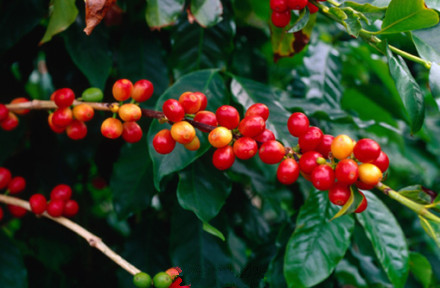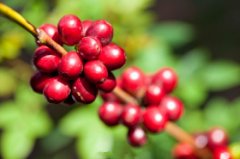Arabica, the most traditional Arabica coffee variety.

Arabica bean
Scientific name coffea arabica (Arabica bean)
Family and genus: coffee genus of Rubiaceae
Coffee trees can be divided into two main varieties: Arabica (coffea arabica) and Robusta (coffea robusta/coffea canephora) (rare on the market).
Arabica (Coffea arabica) is the most traditional Arabica coffee variety. Originally from East Africa, coffee was monopolized by the Arab world for a long time before the 15th century, so it was called "Arabian coffee" by Europeans.
It turned out that all the commercial coffee in the world were small-grain coffee, but at the end of the 19th century, there was a large-scale disease, and growers began to look for other disease-resistant varieties. At present, small-grain coffee is still the main variety of coffee, accounting for about 3% of the world's total coffee output. It is mainly grown in Latin American countries, but also partly in Indonesia and the Pacific islands. At present, the geographical and climatic conditions of Brazil, the largest coffee producer in the world, are very suitable for the growth of small fruit coffee, and the main coffee varieties planted are also small grain coffee. Brazil's coffee production accounts for more than 1 inch of the world's total output.
The fruit of small-grain coffee is smaller than that of medium-grain coffee and large-grain coffee. The berries are oval and generally contain two seeds, the so-called "coffee beans".
Subspecies:
The three early subspecies in the Arabica species (Coffea arabica) series are ∶ blue mountain subspecies (varietal Blue Mountain), Tibica subspecies (varietal Typica) and Bourbon subspecies (varietal Bourbon). Jamaica Blue Mountain is recognized as the best coffee in the world. Tibica coffee, which is native to Ethiopia and southeastern Sudan, is the most widely cultivated variety of coffee in the Western Hemisphere and has a higher yield in Hawaii. Hawaii Kona is on a par with Blue Mountain coffee, with a price difference of only $1 to $3. The bourbon subspecies was introduced to America by French immigrants in the 18th century from the island of Island of Bourbon (today's French island of Reunion in the Indian Ocean east of Madagascar). It is now widely cultivated in the Western Hemisphere, such as Brazil, and a small amount in Yunnan, China. The caffeine content of Bobang subspecies is 20% to 30% higher than that of Tibica subspecies, but less than most coffee subspecies. At first, the main branch and trunk grew upward at 45 degrees, and with the fruit load, the lateral branches were denser, the fruit was more, and the yield was higher. But the berries are smaller and ripen faster, so they are not resistant to strong winds and heavy rain. Bourbon coffee is a variety of small-grain coffee second only to Tibica. It has more fruit and higher yield, but smaller berries and slower ripening.
The small-grain coffee grown in Yunnan, China is mainly Tibika and Bobang subspecies. From the botanical point of view of coffee, Yunnan small-grain coffee is genetically close to the best blue mountains of Jamaica (Jamaica Blue Mountain) and Kona of Hawaii.
Important Notice :
前街咖啡 FrontStreet Coffee has moved to new addredd:
FrontStreet Coffee Address: 315,Donghua East Road,GuangZhou
Tel:020 38364473
- Prev

Growth Environment and brewing of small Coffee
Small grain coffee scientific name: Coffea arabica family genus: Rubiaceae coffee genus morphological characteristics: small trees or large shrubs, plant height 5 meters 8 meters. Base usually much branched, old branches gray-white. Nodes inflated, young branches glabrous. Leaves thinly leathery-ovate-lanceolate or lanceolate, apex long acuminate, base cuneate or slightly obtuse, entire or shallowly wavy, both surfaces glabrous. Cymes several clustered in leaf axils
- Next

Coffee knowledge large collection of fine coffee beans introduced
Brazil (South America) Santos Coffee: The taste is mellow, neutral, and can be boiled directly, or mixed with other types of coffee beans. It is also a good choice. II. Colombia (South America) Mantenin: Rich and solid in taste, with a pleasant sour taste. Aroma mellow, moderate acidity, rich sweetness is very interesting, suitable for deep baking, emitting a strong aroma
Related
- Guji coffee producing area of Guji, Ethiopia: Humbela, Shakiso, Wulaga
- What is the most expensive variety of Qiloso in BOP multi-variety group?
- How to store the coffee beans bought home?
- Why are Yemeni coffee beans so rare now?
- Ethiopian Sidamo all Red Fruit Sun Sun Santa Vini Coffee beans
- SOE is mostly sour? What does it mean? Is it a single bean? what's the difference between it and Italian blending?
- Is Italian coffee beans suitable for making hand-brewed coffee?
- How to choose coffee beans when making cold coffee? What kind of coffee beans are suitable for making cold coffee?
- Just entered the pit to make coffee, what kind of coffee beans should be chosen?
- Can only Japan buy real Blue Mountain Coffee? What are authentic Jamaican Blue Mountain coffee beans?

